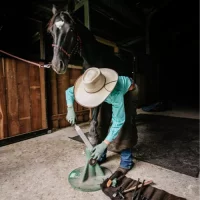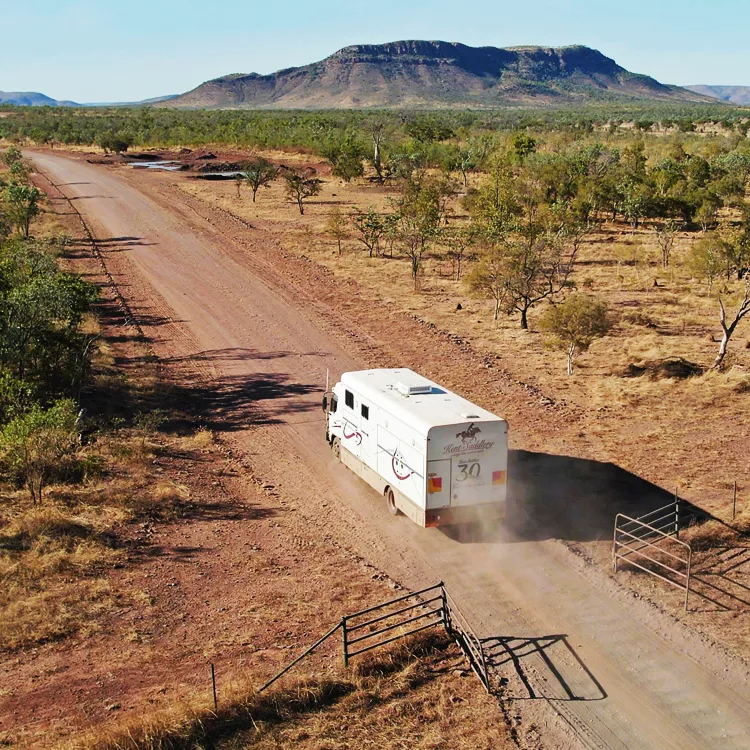Rayham and Ina Francis
Founders of the Clovely Horse Care range of products.
Rayham and Ina Francis were living in Toowoomba QLD where they made the Clovely Cut Cure and Clovely Hoof Care products when we began our association with Clovely Horse Products. Sadly, Rayham passed away at the age of 90 in January 2014.
From 2010, Rayham and Ina’s daughter, Joanne, with a lively interest in the care and health of horses, took over the production and marketing of Cut Cure/Hoof Care, and we at Kent Saddlery are pleased to be able to continue our association with the Francis family, and we’re pleased to be providing a ready supply of a product which many of our customers recommend.
Rayham and Ina’s life stories follows…
Toowoomba, Qld
“It hasn’t been an idle life”
“Hovenden” the home of Rayham and Ina Francis, is tucked away at the end of a quiet cul-de-sac in a picturesque part of Toowoomba, Qld. It is representative of a part of what can be described as a very full life.
Rayham Francis was born in October 1923 and grew up in Brisbane. During the depression, Rayham spent many hours assisting his father, a surveyor, who contracted to design and build golf courses and parks in bushland and swamp areas. After the Junior year at Brisbane Boys College Rayham worked in an accountants office for 18months, and when his parents drew a property in a land Ballot in 1938, they moved to ‘Cairo’’ near Clermont, Qld. Rayham worked long and hard for his father to develop the 100,000 acre property which initially was not much more than one huge paddock. “He was a hard task master”, explains Rayham, and a desire to prove himself as ‘a worthwhile citizen’ to his father is what drove the young Rayham, forging an ability to take hold of seemingly impossible tasks, and see them through to completion.
In 1945 Rayham set out for the Gulf Country of Qld and at “Abingdon”, Georgetown, he spent two years working with cattle, some of them wild, and helped run the stations’ Hereford stud. In 1948 he spent six and a half months droving a mob of 1500 head of cattle from Abingdon south to Alpha, Qld. From Abingdon he moved to “Elystan Station”, Gayndah, to work for his uncle, Edward Kent. Rayham explains that “during this time Ina met me!” Ina was the daughter of DV Wagner of “Aranbanga”, and she comments … “I led a simple little life til I met Rayham”. They were married in 1951, and shortly after took up a position with the Department of Primary Industries helping to establish the Australian Meat Board’s Brian Pastures Research Station near Gayndah. Their house was an old boundary riders’ hut; no phone, no electricity, no running water to the house, a shower under the tank, and an old fashioned wood stove. During this time their son Michael was born and Rayham is quick to affirm that “no matter where we were, we always managed to renovate, and Ina always made any house into a home”. The Australian Meat Board Chairman at the time would often arrive at their home and immediately ask, “Are Ina’s scones on?”
After leaving Brian Pastures, they spent time at their families’ properties and in 1956 their daughter Jane was born. In 1957 they moved to take up a Management position at “Wheatleigh“, near Charleville.
They arrived at Wheatleigh in a ute, carrying personal belongings, two kids, a cat and a dog. An old fella who met them said, “No wonder you got through – you’ve got a cat with you!” They expected rolling plains and heat fields, but the country was covered with mulga! It was 60 miles to town, with 14 gates to open, and plenty of bulldust. Ina is cheerful ……, “I really learned to drive in bulldust, which was quite exciting!”.
However, the time at Wheatleigh was “the first time on our own, we became individuals, and it really was the start of our life”. It was also the first time they’d handled sheep, and with a 400 bale clip to process, Rayham tackled the task with enthusiasm, and adapted successfully to the new challenge. Coming from different country, it was also an introduction to bore drains.
In 1959, life changed dramatically when the house caught fire and burned down. Fortunately it was shearing time; fourteen shearers saw the Tire and raced to help rescue furniture, which included a camphor box. “We got quite a bit out; but not a stitch of clothes except the ones we were wearing”. After the Tire, the family lived in the shearers shed with temperatures of 114ºF, reliant on hot bore water, and literally toughing it out. Wheatleigh was then sold, and the Francis family spent a short time on a property near Tambo, Qld. It was pulled Brigalow country, which had not been burnt, and mustering the sheep and cattle was a challenge for Rayham.
Then came another move; this time to “Barambah Station” near Goomeri, Qld. Rayham describes Barambah as “a managers dream. I was fully responsible for everything and was allowed to be a manager”. Barambah was an historic 11,000 acre property in the South Burnett, and with typical energy and optimism, Rayham and Ina re-established one of the oldest Hereford studs in Australia, until it became a major source of stud and herd bulls for the Burnett district.
In 1967, 68 Barambah was put on the market, and an “unheard of opportunity” allowed Rayham and Ina to buy a small adjoining property with two miles of Barambah Creek running through it. This was the start of their own property “ Clovely”, their much loved home for the next 32 years. When they left Barambah, Rayham received his first ever bonus … one stud bull and ten stud cows, and these were the foundation stock for their own Hereford stud.
As time went by, they were able to buy up four neighbouring dairy farms which were originally soldiers settlers blocks. They were granted an irrigation license for 684 mega litres of water from Barambah Creek and built a private weir (named the Francis weir) and, Ina quips “we grew lucerne…..didn’t we dear?” “Yes dear” answers Rayham and tells the story of 1100 bales of hay washed down the creek in a flash flood . They were not popular with some of the neighbours, whose fences were damaged in the process.
During all the years of shifting and readjusting, Rayhams’ keen interest and passion for the benefit of the cattle industry ignited and grew. He became totally committed to work with the United Graziers Association, the Cattle Council of Australia, the Qld Meat Authority, the Graziers Association of South East Qld, and the Australian and Qld Rural Industry Training Councils.
He worked tirelessly to improve conditions for travelling stock (spelling paddocks and access to watering points), and applied himself both physically and mentally to the many causes associated with live sheep and cattle export, maintaining and organising meat exports to Japan, as well as contributing to the local communities in which he and Ina lived.
These commitments involved time and long travelling distances, and Ina was left behind to keep things going. She had a great little helper in Joanne, born in 1960. From three years of age Joanne was involved with the mustering, often bringing up the tail. Her Dad describes her as “handy” and Ina comments … “We put our vibrancy down to Joanne.” Ina, who describes her own childhood as ‘Idyllic’, had practical, solid training in stock work and became a keen judge of cattle. She consistently selected the best cattle for the local butcher, as well as bulls for other markets. At the “Clovely” property Ina rammed fence posts and spent a lot of time round the kitchen stove and sink. Three thousand signatures in the visitors book are an indication of the welcome extended to everybody.
Rayham and Ina have not allowed the years to slow them down, and with passionate enthusiasm, and an uncanny resemblance to Prof. Julius Sunder Miller, Rayham has worked tirelessly on a project which has aimed to enhance the quality of grain for cattle in feedlots, the production of ethanol, with protein enriched grain and water as a by product.
Ina was actively involved in this venture … “that was a wonderful thing; I really had my heart in that one.” So much so, that in the initial stages of separating water from the grain, Ina was willing to spend hours perched on top of a “very high” tank, manually rubbing grain over gauze. She reflects, “Rayham was ahead of his time in lots of ways… always jumping the gun and getting into trouble!”
There’s a pause, and Ina goes on … “The good old Cut Cure and Hoof Care; it’s the best one,” and Rayham agrees… “it is the best one!” The camphor box, rescued from the Tire at ‘Wheatleigh’ in 1959, contained a recipe written on a slip of paper which an old Irish horse handler had given Rayham during the time he’d spent in the Gulf of Qld. Since moving to Toowoomba, Rayham and Ina have concentrated on the production of Cut Cure and Hoof Care; mixing, stirring and filling the pots with the “secret” mix of ingredients.
The couple have worked together, even when Rayham was frequently away from home. Ina’s loyalty, determination, and positive outlook are revealed when she says, “We’ve had a good life; didn’t make a fortune but achievements are not always in wealth. We’ve had to work our passage, haven’t we Rayham? … which is good.” Rayham describes their relationships as one that “couldn’t be broken … no matter where I went, she never said Nay!” Ina responds “I would go anywhere with him”, but with a hint of longing continues … “I’m sorry we didn’t get to the Northern Territory; I would love to have gone there.”
From a Qld Government position of “Temporary Assistant Advisor on Probation with the Cattle Husbandry Branch” to recipient of an Australia Medal award on 26 January 1997, Rayham Francis overflows with energy and a zest for life, and his eyes light up with fiery enthusiasm when he speaks of the past, the present, and possibilities for the future. His son Michael, describes his Dad as “Honest, uncompromising in his resolve, loyal, with the heart of a terrier.” Rayham and Ina Francis are an awesome couple who convincingly live out a different kind of retirement. They cheerfully admit, “It hasn’t been an idle life.”
Image captions:
1) Rayham and Ina Francis
2) Brian Pastures Hut
3) Landrover and trailer used to cart Telephone Poles.
4) Gayndah Show 1950 “Where it all began”
5) Clovely Homestead















